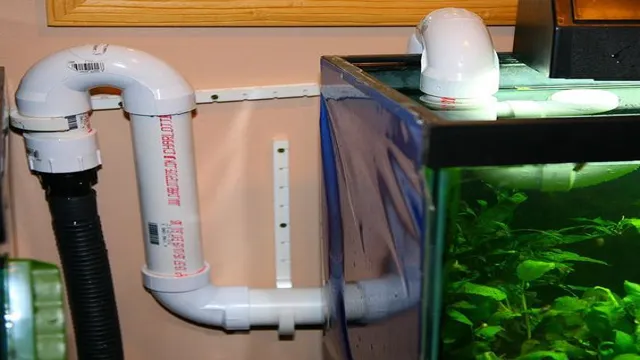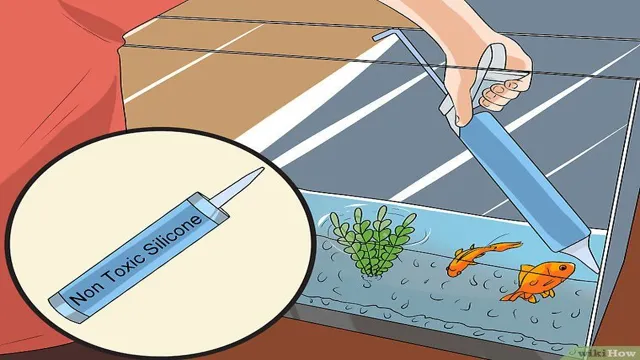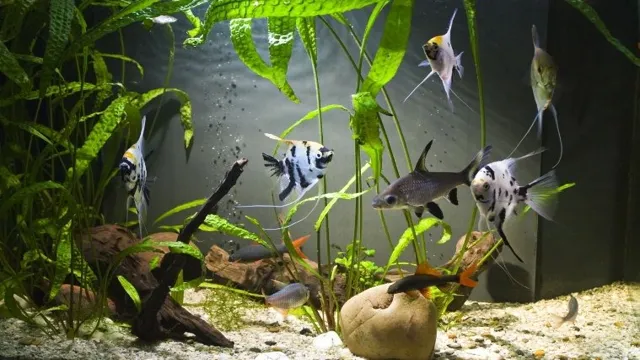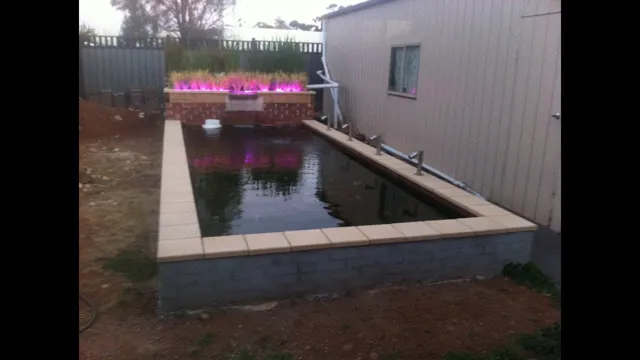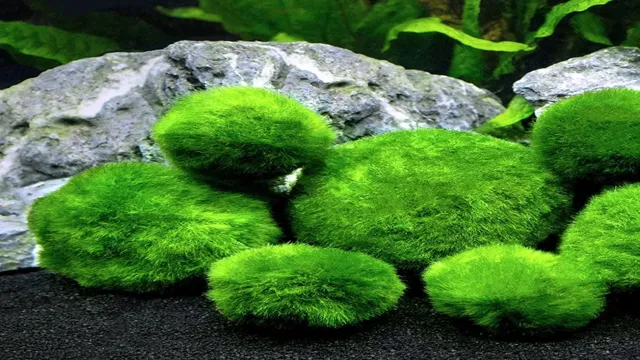Are you looking for a way to improve your aquarium’s filtration system? One effective solution is an aquarium overflow. This device allows for the circulation of water between your aquarium and an external sump system, creating a natural process of removing waste and improving water quality. But where do you start when it comes to creating an aquarium overflow? Don’t worry, we’ve got you covered.
In this blog post, we’ll be discussing the steps on how to create an aquarium overflow and the benefits it provides. You don’t need to be an expert in plumbing or aquarium maintenance to follow along, so grab your tools and let’s dive in!
Understanding the Purpose of an Aquarium Overflow
If you’re a fish enthusiast, you understand the importance of having the right equipment and setups for your fish to thrive. One necessary component is an aquarium overflow. A fish tank overflow works by regulating the water level and preventing it from overflowing.
It’s also crucial in removing excess debris and waste from the tank, ensuring a cleaner and healthier environment for your fish. If you’re wondering how to make an aquarium overflow, the process involves drilling a hole into the tank and installing an overflow box or drilling a siphon-like system just below the desired water level. With proper installation and maintenance, an aquarium overflow can positively impact your fish’s health and your aquarium’s overall cleanliness.
So, make sure it’s a part of your aquarium setup.
Preventing Overflow and Maintaining Water Level
Aquarium Overflow If you are an aquarium enthusiast, you understand how crucial it is to maintain a consistent water level in your tank. However, maintaining such a level can be a bit of a challenge. Fortunately, aquarium overflows have been created to make this task more manageable.
An overflow is a simple device designed to prevent water from overflowing from the aquarium. This involves siphoning excess water from the tank and transferring it to a filter, where it is then processed and returned to the tank. This process helps to keep the water level in the aquarium stable and prevent any potential flooding disasters.
In essence, an aquarium overflow is a lifesaver for your beloved aquatic inhabitants.
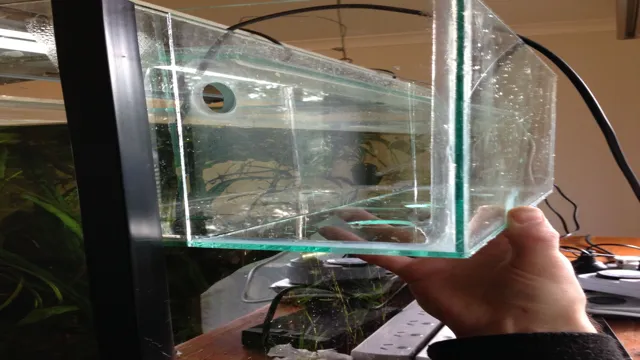
Ensuring Proper Drainage and Filtration
An aquarium overflow is a crucial piece of equipment that serves two main purposes – proper drainage and filtration. The overflow helps to remove excess water from the tank, ensuring that the water level stays consistent. As water flows out through the overflow, it is directed through a filter system, which removes any waste or debris.
This ensures that the water remains clean and healthy for your aquatic inhabitants. The key to proper filtration and drainage is making sure that the overflow is sized appropriately for your aquarium, taking into account the type and number of fish you have, as well as the size and shape of your tank. With the right overflow, you can maintain a balanced and thriving aquatic environment for your fish.
Materials Needed for an Aquarium Overflow
If you’re looking to make an aquarium overflow, there are a few materials you’ll need to get started. Firstly, you’ll need a tank and a stand that can hold the weight of the water and equipment. Additionally, you’ll need a drilled overflow box, bulkhead fittings, PVC piping, and a return pump to create the necessary flow of water.
You may also want to invest in a surface skimmer to keep debris from building up on the water’s surface. Finally, it’s important to invest in high-quality silicone sealant to ensure everything stays securely in place. Keep in mind that building an aquarium overflow requires some technical knowledge and skill, so it’s important to follow instructions carefully and consult with a professional if necessary.
With the right materials and attention to detail, you can create a functional and effective aquarium overflow for your aquatic friends.
PVC Pipes and Fittings
When it comes to setting up an aquarium overflow system, there are certain materials that you will need to have on hand. One of the most important items is PVC pipes and fittings. These are essential for creating the plumbing system that will direct water from the overflow to the sump below.
PVC pipes come in various sizes, so be sure to choose the right ones for your specific setup. You will also need PVC fittings such as elbows, tees, and couplers to create the necessary connections and angles. It’s important to use high-quality PVC materials that are durable and won’t leach any harmful chemicals into the aquarium water.
Always remember to measure twice and cut once, and use PVC cement to secure all connections. With the right materials and a little bit of know-how, you can build a reliable and efficient aquarium overflow system that will keep your fish happy and healthy.
Drain Pipes and Bulkheads
When it comes to setting up an aquarium overflow, there are a few key materials you’ll need to ensure it functions properly. First and foremost, you’ll need a drain pipe and a bulkhead fitting to connect it to your tank. The drain pipe will allow water to overflow from the tank and be directed into a sump or other filtration system. (See Also: How to Make Aquarium Driftwood Sink: The Ultimate Guide for Successful Aquascaping)
The bulkhead fitting ensures a secure and watertight connection between the drain pipe and the tank. It’s important to choose the right size bulkhead fitting for your tank, as a loose or ill-fitting one can cause leaks and flooding. Other materials you may need include PVC pipes and fittings to create the plumbing system, a drill to create the necessary holes in the tank for the drain pipe and bulkhead, and silicone sealant to secure the bulkhead.
By gathering these materials and carefully following the necessary steps, you can create a reliable and effective aquarium overflow system that will help keep your tank clean and healthy.
Silicone and Sealants
When it comes to setting up an aquarium overflow, silicone and sealants are essential materials that you’ll need. Silicone is a versatile adhesive that is ideal for sealing joints in your aquarium overflow, helping to prevent leaks and keeping the water where it should be. There are different types of silicone that you can use, with some being specifically designed for underwater use.
You should always ensure that you choose a silicone that is safe for use in an aquarium, and follow the manufacturer’s instructions carefully. Sealants, on the other hand, are designed to fill gaps and cracks, creating a watertight seal that prevents water from escaping. These can be particularly useful when setting up aquarium overflows, as they can help to ensure that your system is as leak-free as possible.
So, whether you’re setting up a new aquarium or upgrading an existing setup, make sure you have the right silicone and sealants on hand to help keep your tank water where it belongs.
Building Your Aquarium Overflow
If you want to create a custom aquarium overflow, it’s easier than you might think. First, you’ll need to gather some supplies. This includes PVC piping, a plumbing adapter, a bulkhead, a drill, and a saw.
You’ll also need to measure your tank to make sure you get the right size for your overflow. Once you have all the supplies, you can start by drilling a hole in your tank for the bulkhead. Then, attach the plumbing adapter to the bulkhead and run your PVC piping from the adapter to your sump.
It’s important to make sure the PVC is securely fit and sealed to prevent leaks. Finally, test your overflow to make sure it’s working properly. With a little bit of patience and attention to detail, you can have your custom aquarium overflow up and running in no time.
So why not give it a try and see how it enhances your aquarium setup?
Measuring and Cutting PVC Pipes
One of the most important steps when building your aquarium overflow is measuring and cutting PVC pipes. PVC pipes are essential components in most aquarium overflow systems and require precise measurements to ensure a proper fit and function. The first step is to measure the length of the pipe required and make a mark where you need to cut.
Using a PVC pipe cutter or a hacksaw, cut along the marked line in a straight line, ensuring that the edge is clean and straight. If the PVC pipe is not straight, use sandpaper or a blade to smooth out the rough edges. Remember to use safety equipment like gloves and goggles when cutting PVC pipes.
Repeat this process for all necessary PVC pipes in your aquarium overflow system. Properly measuring and cutting PVC pipes is essential to ensure that your aquarium overflow functions as intended, and preventing leaks and damage to your aquarium.
Assembling the Overflow Box and Pipes
Assembling the overflow box and pipes is a crucial step in building your aquarium overflow system. The overflow box acts as a barrier that draws water from the tank into the drainage pipes, keeping the water level constant. Before assembling, ensure that all the parts of your overflow system are clean and free from debris that can clog the pipes.
Connect the overflow box to the tank with suction cups and attach the drainage pipes to the sides of the box. The pipes should be cut to length to fit your specific aquarium’s height, and ensure that there is a slight downhill angle for proper water flow. Also, insert a ball valve or gate valve in the drainage line to control the water flow.
Finally, test the overflow system to ensure that everything is working correctly before filling your aquarium with water. A well-assembled overflow box and pipes will ensure efficient water turnover in your aquarium and guarantee the safety of your fish.
Installation of the Aquarium Overflow
Are you a beginner in the aquarium world and looking for a way to make an aquarium overflow? It sounds complicated, but it’s actually not too difficult. The first step is to gather the necessary materials, including a PVC pipe, bulkhead fitting, and an aquarium overflow box. Then, drill a hole in the aquarium where you want the overflow box to be placed and attach the bulkhead fitting. (See Also: How to DIY CO2 System for Aquarium Plants Tutorial: Step-by-Step Guide)
Connect the PVC pipe to the bulkhead fitting and run it into the overflow box. Lastly, make sure the water level in the aquarium is at the appropriate height and that the overflow system is working correctly by testing it with a hose. With these steps, you’ll be able to install an aquarium overflow and protect your aquatic pets from possible flooding.
Preparing the Tank and Drilling Holes
Installing an aquarium overflow is an essential part of setting up a fish tank. Before getting started, ensure that the tank is clean and free of any debris. Next, mark the area where the overflow will be installed, and using a hole saw, drill a hole in the marked area.
Ensure that the hole is the right size to fit the overflow bulkhead. Once the hole is drilled, clean it thoroughly to ensure that no plastic shavings are left behind. Then, install the bulkhead by screwing it into the hole.
Check to make sure that the bulkhead is tight and secure, and then attach the plumbing to it. Ensure that the plumbing is the right size to handle the amount of water that the tank will be holding. Finally, test the overflow system to make sure that it is working correctly and that there are no leaks.
By installing an aquarium overflow properly, you can ensure that your fish tank is properly aerated and that the water remains clean and clear.
Attaching the Overflow Box to the Tank
When it comes to aquariums, an overflow box is an indispensable component that helps to maintain water levels and prevent floods. The process of attaching an overflow box to your tank may seem daunting at first, but it’s actually a pretty straightforward job that can be easily accomplished with a few basic tools. First, you’ll need to select an appropriate overflow box that’s compatible with the size and shape of your tank.
Next, position the box on the back of your tank, making sure it’s level and securely attached. Depending on the type of box you’ve chosen, you may need to drill holes in your tank’s glass for tubes and other fittings. Then, connect the overflow box to your sump or filtration system and test it to ensure it’s functioning properly.
With a bit of patience and attention to detail, installing an aquarium overflow can be a hassle-free process that will provide real benefits to your aquatic setup. Remember to take care during installation to prevent leaks and maintain the integrity of your tank.
Connecting the Drain Pipes and Fittings
One crucial step in the installation of an aquarium overflow is connecting the drain pipes and fittings. It’s important to ensure that the pipes and fittings are securely connected and leak-free to prevent any potential water damage to your home. To begin, make sure that the pipes and fittings you’re using are the correct size for your aquarium.
Then, carefully measure and cut the pipes to the necessary lengths, taking care not to damage them. Next, use PVC cement to attach the fittings to the pipes, making sure to follow the manufacturer’s instructions. Once the fittings are securely in place, connect the pipes to the overflow and the sump, taking care to check that all connections are tight and there are no leaks.
By following this process, you can be sure that your aquarium overflow will work properly and safely.
Maintenance of the Aquarium Overflow
Aquarium overflows are important for maintaining the cleanliness and functionality of your aquarium. To make an aquarium overflow, you’ll need a few basic materials such as PVC pipes, a bulkhead fitting, and an overflow box. Once the overflow is in place, it’s important to regularly clean and maintain it to ensure it’s working properly.
One important step in maintenance is to regularly check the overflow for clogs, as even small blockages can cause serious problems. Additionally, it’s important to clean the overflow box and its associated components on a regular basis, removing any debris or algae buildup. Finally, it’s a good idea to clean or replace the filter socks or filter pads within the overflow box to maintain optimal performance.
With proper maintenance, your aquarium overflow can help keep your tank clean and healthy for your aquatic pets.
Cleaning and Clearing Clogs
Aquarium overflow Maintaining an aquarium overflow is crucial for the general health of your fish and aquatic plants. A clogged overflow can result in excess water, causing damage to your equipment or a spill, which could harm your carpet. You should dedicate some time every week to clean and clear out any clogs from your aquarium overflow.
The process involves turning off the filter, unplugging any equipment, and removing debris that is obstructing the overflow. You can use a handheld vacuum or a siphon to remove any dirt, waste or debris that might clog the overflow, being sure not to flush anything down the drain, through rubber washing up bowls, or down a toilet. Neglecting maintenance can lead to a major expense that could have been easily avoided, so make sure to take care of your aquarium appropriately. (See Also: How to Cycle Aquarium with Plants: A Complete Guide for Beginners)
You’ll be rewarded with a clean and personally fulfilling experience, and your pet fish or plants will thrive.
Replacing Worn Out Parts
Aquarium Overflow Maintaining the aquarium overflow is vital for the health of your aquatic pets. Over time, parts of the overflow, such as the plastic tubing and suction cups, may become worn out and require replacement. It is crucial to monitor these parts regularly and replace them as needed to prevent leaks and ensure the overflow continues to function properly.
When replacing these parts, it is essential to choose high-quality materials that are suitable for your aquarium’s environment. For instance, silicone tubing and strong suction cups are ideal options that can withstand the water’s pressure and ensure the overflow remains secure. By promptly replacing worn-out parts, you can maintain the aquarium’s cleanliness, prevent overflow malfunctions, and keep your fish safe and healthy.
Remember to conduct regular maintenance checks to ensure your aquarium runs smoothly and provides a healthy and safe environment for your aquatic pets.
Conclusion
In conclusion, making an aquarium overflow is a bit like writing a novel – it requires careful planning, attention to detail, and a willingness to think outside the box. But once you have all the pieces in place, the result is a masterpiece that you can appreciate for years to come. So whether you’re an experienced aquarist or just starting out, don’t be afraid to take the plunge and create your own aquarium overflow.
Your fish (and your inner DIY enthusiast) will thank you!”
FAQs
What is an aquarium overflow?
An aquarium overflow is a device used to transport water from the aquarium to an external filtration system, preventing water from overflowing out of the tank.
Why do I need an aquarium overflow?
An aquarium overflow is necessary for larger tanks because it helps to maintain a consistent water level, increases the efficiency of external filtration systems, and prevents water from overflowing out of the tank.
What are the different types of aquarium overflows?
There are several types of aquarium overflows, including hang-on-back overflows, siphon overflows, drilled overflows, and overflow boxes. Each type has its own advantages and disadvantages.
How do I install an aquarium overflow?
The process of installing an aquarium overflow will depend on the type you have chosen. In general, you will need to fit the overflow onto your tank, install the necessary plumbing, and connect it to an external filtration system.
What should I consider when choosing an aquarium overflow?
When choosing an aquarium overflow, you should consider the size of your tank, the type of external filtration system you plan to use, and the amount of noise the overflow makes. You should also look for a high-quality device that is durable and reliable.
Can I make my own aquarium overflow?
It is possible to create your own aquarium overflow, but this should only be attempted by experienced hobbyists. Making mistakes during the process can lead to flooding and other serious problems.
How can I prevent my aquarium overflow from clogging?
To prevent your aquarium overflow from clogging, you should regularly inspect and clean it. You can also install a pre-filter to trap larger debris and prevent it from entering the overflow.

